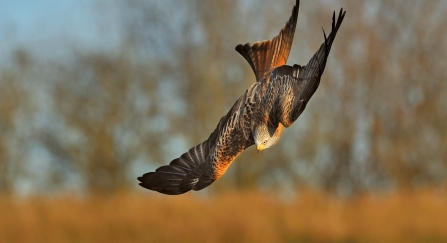Managing dykes, ditches and drains
The Great Fen has inherited a complex and efficient network of drains, dykes and ditches whose primary purpose has been to get water away from the arable farmland as quickly as possible. Generations of farmers have deepened and straightened field ditches, and as a result, the peat fields rarely have any of the standing water that can be seen in other parts of the country after heavy rainfall.

Red Kite (Milvus milvus) diving Wales - Andy Rouse/2020VISION
A major aim of the project is to retain water, rather than to drain it away. Ideally, excess water will be taken from the main drains during the winter and retained on the Great Fen area throughout the summer months. However, even though it is a large area, the Great Fen is a minor part of the wider fenland area, where drainage and flood defences are of primary concern.
These concerns are dealt with at a local level by Internal Drainage Boards (IDBs), which were originally set up in the 18th century. The IDBs have responsibility for pumping stations and major dykes, some of which cross the Great Fen area. Over a wider area in this part of the fens, the Middle Level Commissioners (one of the five Great Fen partner organisations) are responsible for flood defence and water-level management. There are 33 IDBs within the Middle Level and the Commissioners are responsible for the more major watercourses such as Great Ravely Drain, which borders Woodwalton Fen.
1) Diverting a main drainage dyke - getting water through
One of the main IDB dykes that crosses the Great Fen area has been responsible for taking water from the farms south of Holme Fen, north towards the Old River Nene. While this drainage is still most important, its original route would make wetland creation difficult so, after much discussion, a new route was agreed and an entirely new dyke is being constructed. Work began in early 2013 and the picture below left shows excavation in progress near the New Decoy farm buildings. On the right, by September the sides of the deep dyke already had vegetation beginning to encroach.
The next stage of this drainage diversion will be entending the dyke across the B660 road. A culvert will be bored through the bank on which the road runs and the new dyke will be almost complete. However, it will be another year of fine-tuning and testing before the switch is made and drainage water flows freely along its new route.
2) Creating a slacker - letting water in
The major watercourses that border the Great Fen area on the north and east sides are generally at a higher level than the adjacent farmland - the water has been drained from arable fields into IDB dykes and then pumped up into these waterways to flow away eventually into the sea at the Wash. This difference in height means that, in theory at least, it should be relatively easy to allow water from the main waterways to run down into the adjacent fields where it can be used to create wetland habitats. The drainage water can flow down to become habitat water.
An example of this is at Old Decoy Farm which lies below the level of the River Nene as it flows north between high clay banks. Here, in the summer of 2013, the Middle Level Commissioners built a "slacker" so that, at certain times of the year water can be allowed to flow down from the river onto parts of Old Decoy farm. The slacker is essentially a large pipe through the river bank with the means to regulate the flow of the water. Immediately after this work there was not much to see, but this simple construction will play a major part in creating future wetland habitats.
With the slacker built, the next stage in September 2013 was to create waterways to distribute water across the fields. This work was carrried out by a contractor under the watchful eye of the Great Fen Restoration team.
3) Re-profiling ditches - keeping water in
It's all very well to allow water down onto fields that are intended to be wet pasture. It is also essential not to let it drain immediately away. For example, at Old Decoy farm there was a ditch that would take that water straight into the IDB dyke on the other side of the farm area. The solution to this problem was simply to fill that ditch in.
Having removed the water's escape route, the remaining network of ditches can be re-used to spread the water across the fields. However, these ditches are often deeper than they need to be. If one side of the ditch is lowered along part or all of its length, then, when it fills with water, the overspill can saturate the adjacent field. So the bank is made less steep and the ditch itself is made shallower.
